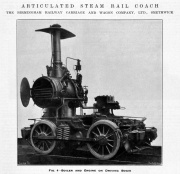Birmingham Railway Carriage and Wagon Co


of Smethwick, near Birmingham
The Birmingham Railway Carriage and Wagon Company also known as The Birmingham Carriage Co and The Birmingham Wagon Co was a railway locomotive and carriage builder, founded in Birmingham and for most of its existence, located at nearby Smethwick, with the factory divided by the boundary between the two places. [1]
The company made not only carriages and wagons, but a range of vehicles, from aeroplanes and gliders to buses, trolleybuses and tanks. Nevertheless, it is as a builder of railway rolling stock that the company is best remembered, exporting to most parts of the new and old worlds. It supplied vehicles to all four of the pre-nationalisation "big four" railway companies (LMS, SR, LNER and GWR), British Rail, Pullman (some of which are still in use) and Wagons Lits, plus railways as diverse as those in Egypt, India, South Africa, Iraq, Malaya and Nigeria, to name but a few.
1854 The company was established.
1855 Public company formed.
1856 The company was registered on 13 September. [2]
1878 Name changed.
1888 Twenty-five ton iron-ore wagon. [3]
1896/7 Directory: Listed for Railway Equipment. [4]
1900 Details of the interior of a hospital carriage. [5]
1910 The company even built Argentina's presidential coach, which still survives.
The company built hospital trains during the Second Boer War, Handley Page bombers and de Havilland DH10s ( Airco) in 1914-1918, and tanks (including the A10 Cruiser, Churchill, Cromwell and Challenger), plus Hamilcar gliders to carry them, in 1939-1945.
1918 Wagon Repairs founded to acquire the wagon-repairing business of wagon-building firms including the Birmingham Railway Carriage and Wagon Co.
1926 Buenos Aires Western Railway awarded contract for 100 cattle wagons.
Before World War II, the company had built steam, petrol and diesel-powered railcars for overseas customers, not to mention bus bodies for Midland Red, and afterwards developed more motive power products, including BR's Class 26, Class 33 (both diesel) and Class 81 (electric) locomotives. Examples of all three types are preserved.
1931 Exhibited at the Buenos Aires Exhibition see Image.[6]
1961 Manufacturers of A.C. electric and diesel electric locomotoves, multiple unit diesel mechanical railcars, carriages and wagons and freight cars, also spares for all types of rolling stock. 2,000 employees. [7]
See Also
Sources of Information
- ↑ [1] Wikipedia
- ↑ The Stock Exchange Year Book 1908
- ↑ The Engineer of 27th April 1888 p342 & p345
- ↑ Peck's Trades Directory of Birmingham, 1896-97:Railway Equipment
- ↑ The Engineer of 12th January 1900. p48
- ↑ The Engineer 1931/03/27
- ↑ 1961 Dun and Bradstreet KBE
- Aeroplanes of the Royal Flying Corps (Military Wing) by J. M. Bruce. Published 1982 ISBN 0-370-30084-x












